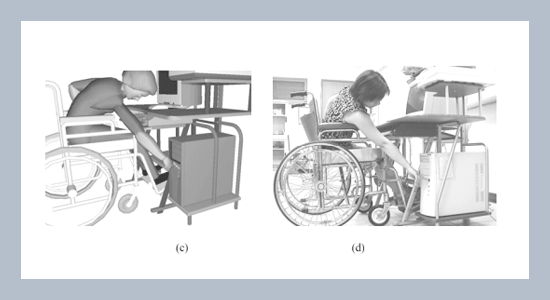REFERENCES
- [1] Jarosz, E. 1996. Determination of the workspace of wheelchair users. International Journal of Industrial Ergonomics, 17: 123-133.
- [2] Kozey, J. W., and Das, B. 2004. Determination of the normal and maximum reach measures of adult wheelchair users. International Journal of Industrial Ergonomics, 33: 205-213.
- [3] Ashworth, J. B., Reuben, D. B., and Benton, L. A. 1994. Functional profile of healthy older persons. Age and Aging, 23: 34-39.
- [4] Babski-Reeves, K., Stanfield, J., and Hughes, L. 2005. Assessment of video display workstation set up on risk factors associated with the development of low back and neck discomfort. International Journal of Industrial Ergonomics, 35: 593-604.
- [5] Fogleman, M., and Lewis, R. J. 2002. Factors associated with self-reported musculoskeletal discomfort in video display terminal (VDT) users. International Journal of Industrial Ergonomics, 29: 311-318.
- [6] Gerr, F., Marcus, M., and Monteilh, C. 2004. Epidemiology of musculoskeletal disorders among computer users: lesson learned from the role of posture and keyboard use. Journal of Electromyography and Kinesiology, 14: 25-31.
- [7] Leung, A. W. S., Chan, C. C. H., and He, J. 2004. Structural stability and reliability of the Swedish occupational fatigue inventory among Chinese VDT workers. Applied Ergonomics, 35: 233-241.
- [8] Murata, A., Uetake, A., and Takasawa, Y. 2005. Evaluation of mental fatigue using feature parameter extracted from event-related potential. International Journal of Industrial Ergonomics, 35: 761-770.
- [9] Park, M. Y., Kim, J. Y., and Shin, J. H. 2000. Ergonomic design and evaluation of a new VDT workstation chair with keyboard-mouse support. International Journal of Industrial Ergonomics, 26: 537-548.
- [10] Psihogios, J. P., Sommerich, C. M., Mirka, G. A., and Moon, S. D. 2001. A field evaluation of monitor placement effects in VDT users. Applied Ergonomics, 32: 313-325.
- [11] Das, B., and Kozey, J. W. 1999. Structural anthropometric measurements for wheelchair mobile adults. Applied Ergonomics, 30: 385-390.
- [12] Gyi, D. E., Sims, R. E., Porter, J. M., Marshall, R., and Case, K. 2004, Representing older and disabled people in virtual user trials: data collection methods. Applied Ergonomics, 35: 443-451.
- [13] Paquet, V., and Feathers, D. 2004. An anthropometric study of manual and powered wheelchair users. International Journal of Industrial Ergonomics, 33: 191-204.
- [14] Reed, M. P., Van Roosmalen, L. 2005. A pilot study of a method for assessing the reach capability of wheelchair users for safety belt design. Applied Ergonomics, 36: 523-528.
- [15] Feeney, R. 2000. Approach with special reference to the needs of the disabled person. Proceedings of the IEA 2000/HFES 2000 Congress.
- [16] Tilley, A. R. 2002. “The measure of man and woman: human factors in design”. John Wiley & Sons, New York, 36-37.
- [17] Chi, C. F. 1998. The Task Redesign Manual for Handicapped People, Bureau of Employment and Vocational Training, Council of Labor Affairs, Executive Yuan. (In Chinese)
- [18] Feyen, R., Liu, Y., Chaffin, D., Jimmerson, G., and Joseph, B. 2000. Computer-aided ergonomics: a case study of incorporating ergonomics analysis into workplace design. Applied Ergonomics, 31:291-300.
- [19] Sengupta, A. K., and Das, B. 1997. Human: An autocad based three dimensional anthropometric human model for workstation design. International Journal of Industrial Ergonomics, 19: 345-352.
- [20] Mattila, M. 1996. Computer-aided ergonomics and safety - A challenge for integrated ergonomics. International Journal of Industrial Ergonomics,17: 309-314.
- [21] Porter, J. M., Case, K., Marshall, R., Gyi, D., and Oliver, R. 2004. ‘Beyond Jack and Jill’: designing for individuals using HADRIAN. International Journal of Industrial Ergonomics, 33: 249-264.
- [22] Univ. of Pennsylvania. 1997. JACK. Center for Human Modeling and Simulation, Department of Computer and Information Science, Univ. of Pennsylvania, U.S.A.
- [23] Sundin, A., Ortengren, R., Sjoberg, H. 2000. Proactive human factors engineering analysis in space station design using the computer manikin Jack. Proceedings of SAE Conference on Digital Human Modelling DHMC 2000, Dearborn, Michigan.
- [24] Sundin, A., Christmanson, M., and Ortengren, R. 2000. Use of a computer manikin in participatory design of assembly workstations. In K. Landau (ed.) “Ergonomic Software Tools in Product and Workplace design”, Stuttgart: Ergon Verlag, 204-213.
- [25] Leskinen, T., and Haijanen, J. 1996. Torque on the low back and the weight limits recommended by NIOSH in simulated lifts. Proceedings of the Fourth International Symposium on 3-D Analysis of Human Movement, France.
- [26] Haijanen, J., Leskinen, T., Kuusisto, A., and Laitinen, H. 1996. Redesign of lifting work using a 3-D human modelling software and the revised NIOSH lifting equation. Advances in Occupational Ergonomics and Safety, Finland, 339-344.
- [27] Wang, E. M. Y., Wang, M. J., Yeh, W. Y., Shih, Y. C., and Lin, Y. C. 1999. Development of anthropometric work environment for Taiwanese workers. International Journal of Industrial Ergonomics, 23: 3-8.
- [28] McAtamney, L., and Corlett, E. N. 1993. RULA: a survey method for the investigation of work-related upper limb disorders. Applied Ergonomics, 24: 91-99.
- [29] AT&T Bell Laboratories. 1983. Video display terminals. Short Hills, N. J.
- [30] Institute of Occupational Safety and Health (IOSH), 1999. “Occupational safety and health Guide for VDT workstations”, Publication No. IOSH88 -T- 027. (in Chinese)
- [31] Woodson, W. E., Tillman, B., and Tillman, P. 1992. “Human Factors Design Handbook”, McGraw-Hill, London.
- [32] Guan, S. S., Lin, Y. C., and Ke, L. T. 2001. A study of computer workstation of ergonomics. Proceedings of 8th Annual Meeting & Conference of Ergonomics Society of Taiwan, 229-234. (In Chinese)















